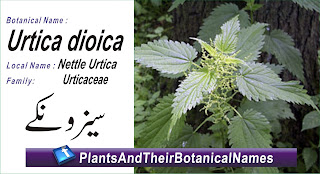Urtica dioica
Common Names: Englis Nettle Urtica
Urdu / Hindi : Bichchu boti بچھو بوٹی / नेटल यूरेटिका
Punjabi : Kunjiکنجی
سنسکرت میںبرشیکااور پشتو میں Sezonkai سیزونکےیا نیخ لرونکے بوٹے
Urtica dioica, commonly known as stinging nettle, is a herbaceous perennial plant belonging to the Urticaceae family. It is native to Europe, Asia, northern Africa, and North America, and it can also be found in various other regions around the world. Stinging nettle is well-known for its characteristic stinging hairs, which can cause irritation upon contact with the skin.
Common Names: Englis Nettle Urtica
Urdu / Hindi : Bichchu boti بچھو بوٹی / नेटल यूरेटिका
Punjabi : Kunjiکنجی
سنسکرت میںبرشیکااور پشتو میں Sezonkai سیزونکےیا نیخ لرونکے بوٹے
Urtica dioica, commonly known as stinging nettle, is a herbaceous perennial plant belonging to the Urticaceae family. It is native to Europe, Asia, northern Africa, and North America, and it can also be found in various other regions around the world. Stinging nettle is well-known for its characteristic stinging hairs, which can cause irritation upon contact with the skin.
Here are some key characteristics and uses of Urtica dioica:
1. Appearance: Stinging nettle is a tall plant that can grow up to 1-2 meters in height. It has opposite, serrated leaves that are heart-shaped and covered with tiny, stinging hairs, known as trichomes. These hairs contain irritants, such as histamines and formic acid, which cause a stinging sensation and skin irritation when touched.
2. Medicinal Uses: Despite its stinging properties, stinging nettle has a long history of medicinal use. Various parts of the plant, including the leaves, roots, and seeds, are used for their therapeutic properties. It is a rich source of vitamins (such as vitamin C and vitamin K), minerals (like iron, calcium, and magnesium), and other beneficial compounds.
3. Traditional Medicine: Stinging nettle has been used in traditional medicine to treat various conditions, including joint pain, allergies, urinary tract infections, and skin disorders. It is also used as a diuretic and to support overall health and wellness.
4. Culinary Uses: Young stinging nettle leaves can be harvested and cooked to remove the stinging hairs, making them safe to eat. They are often used in soups, stews, teas, and other culinary preparations. Stinging nettle is valued for its nutritional content, including its high protein content.
5. Ecological Importance: Stinging nettle plays a vital role in the ecosystem. It serves as a host plant for various butterfly and moth species, providing them with a place to lay eggs and a food source for their caterpillars.
6. Horticultural Uses: Stinging nettle is sometimes used as a natural fertilizer. By steeping the leaves in water, a nutrient-rich liquid can be obtained, which can be used to fertilize plants in the garden.
7. Safety Considerations: While stinging nettle has numerous health benefits, it is important to handle it with care due to its stinging hairs. Wearing gloves or using appropriate harvesting techniques can help avoid skin irritation. Additionally, pregnant or nursing women and individuals taking certain medications should exercise caution and consult a healthcare professional before using stinging nettle medicinally.
In summary, Urtica dioica, or stinging nettle, is a versatile plant with both medicinal and culinary uses. While it may cause skin irritation upon contact, its nutritional value and potential health benefits make it a valuable herb in various cultures and traditional medicine systems.
https://web.facebook.com/PlantsAndTheirBotanicalNames/
https://web.facebook.com/PlantsAndTheirBotanicalNames/





No comments